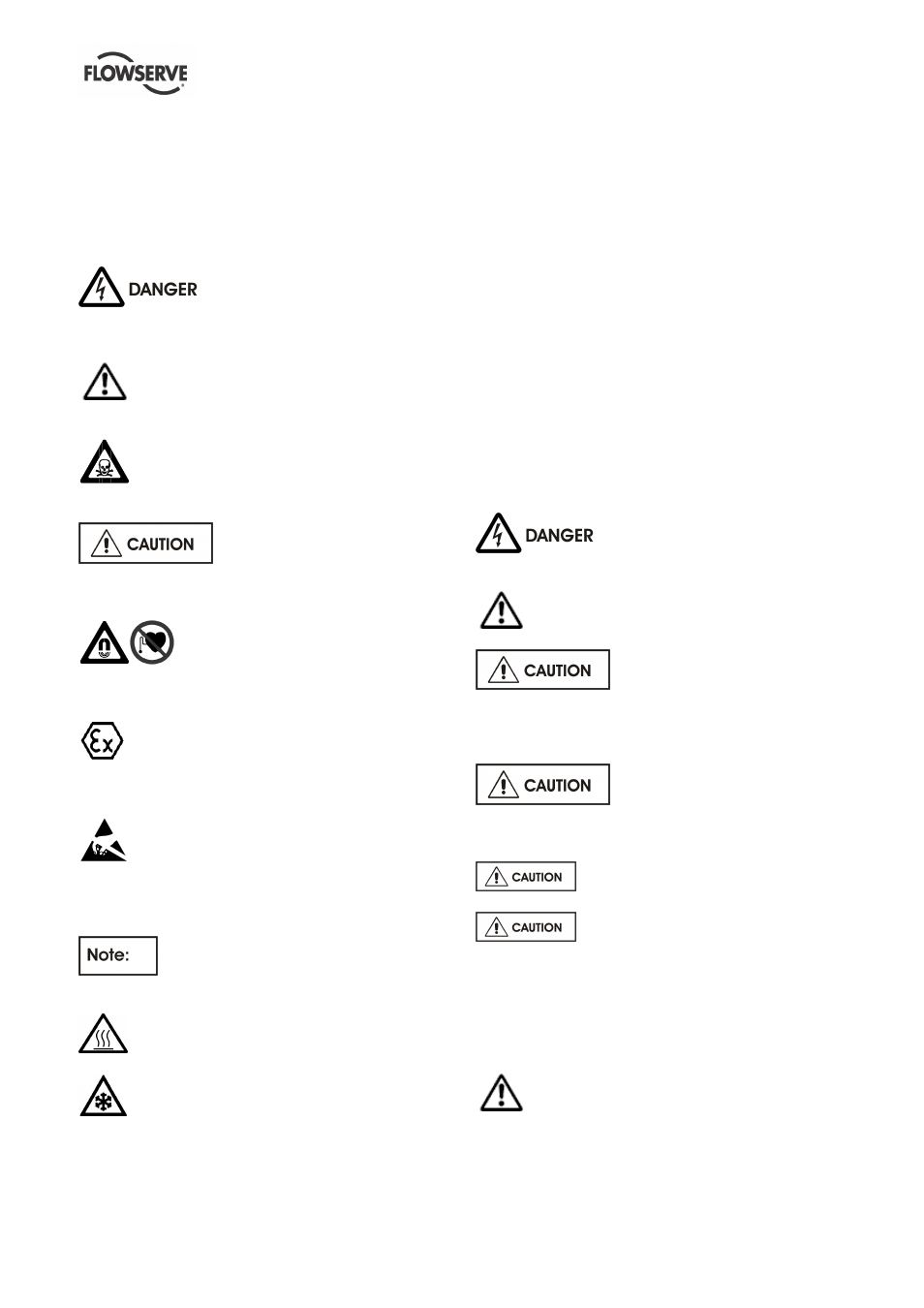6 safety – Flowserve N-Series Worthington User Manual
Page 4

N-SERIES OF THRUST POT USER INSTRUCTIONS ENGLISH 07/14
Page 4 of 20
1.6 Safety
1.6.1 Summary of safety markings
These user instructions contain specific safety
markings where non-observance of an instruction
would cause hazards. The specific safety markings
are:
This symbol indicates electrical safety instructions
where non-compliance will involve a high risk to
personal safety or the loss of life.
This symbol indicates safety instructions
where non-compliance would affect personal safety
and could result in loss of life.
This symbol indicates "hazardous and toxic
fluid" safety instructions where non-compliance would
affect personal safety and could result in loss of life.
This symbol indicates safety
instructions where non-compliance will involve some
risk to safe operation and personal safety and would
damage the equipment or property.
This symbol indicates "strong magnetic
field" safety instructions where non-compliance would
affect personal safety, pacemakers, instruments or
stored data sensitive to magnetic fields.
This symbol indicates explosive atmosphere
marking according to ATEX. It is used in safety
instructions where non-compliance in the hazardous
area would cause the risk of an explosion.
This symbol is used in safety instructions to
remind not to rub non-metallic surfaces with a dry
cloth; ensure the cloth is damp. It is used in safety
instructions where non-compliance in the hazardous
area would cause the risk of an explosion.
The sign is not a safety symbol but
indicates an important instruction in the assembly
process.
This symbol indicates potential risks
connected with extremely high temperatures.
This symbol indicates potential risks
connected with extremely low temperatures.
1.6.2 Personnel qualification and training
All personnel involved in the operation, installation,
inspection and maintenance of the unit must be
qualified to carry out the work involved. If the
personnel in question do not already possess the
necessary knowledge and skill, appropriate training
and instruction must be provided. If required the
operator may commission the manufacturer / supplier
to provide applicable training.
Always co-ordinate repair activity with operations and
health and safety personnel, and follow all plant
safety requirements and applicable safety and health
laws/regulations.
1.6.3 Safety action
This is a summary of conditions and actions to
help prevent injury to personnel and damage to
the environment and to equipment. For products
used in potentially explosive atmospheres
section 1.6.4 also applies.
NEVER DO MAINTENANCE WORK WHILST THE
UNIT IS CONNECTED TO POWER
GUARDS MUST NOT BE REMOVED WHILE
PUMP IS OPERATIONAL
ONLY CHECK DIRECTION OF
MOTOR ROTATION WITH COUPLING ELEMENT/
PINS REMOVED
Starting in reverse direction of rotation will damage
the pump.
ENSURE CORRECT
LUBRICATION (See section 3.0, Commissioning,
startup, operation and shutdown.)
NEVER RUN THE PUMP DRY
DO NOT RUN THE PUMP AT
ABNORMALLY HIGH OR LOW FLOW RATES
Operating at a flow rate higher than normal or at a flow
rate with no back pressure on the pump may overload
the motor and cause cavitation. Low flow rates may
cause a reduction in pump/bearing life, overheating of
the pump, instability and cavitation/vibration.
HANDLING COMPONENTS
Many precision parts have sharp corners and the
wearing of appropriate safety gloves and equipment
is required when handling these components. To lift
heavy pieces above 25 kg (55 lbs) use a crane
